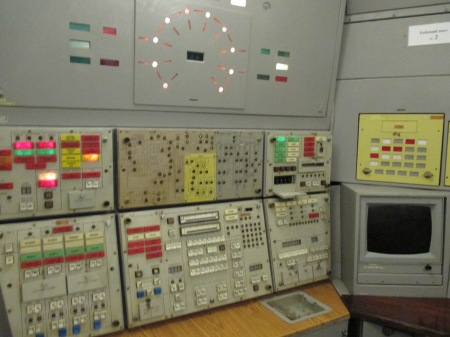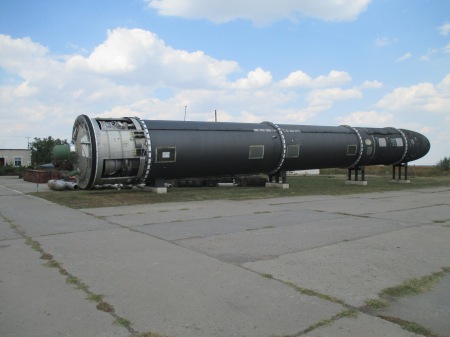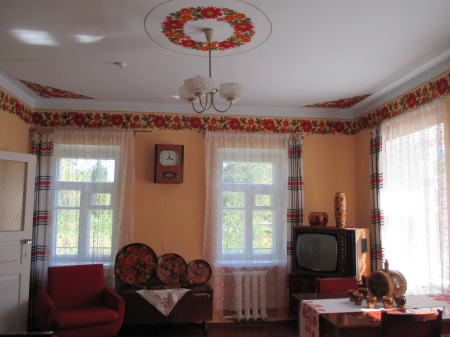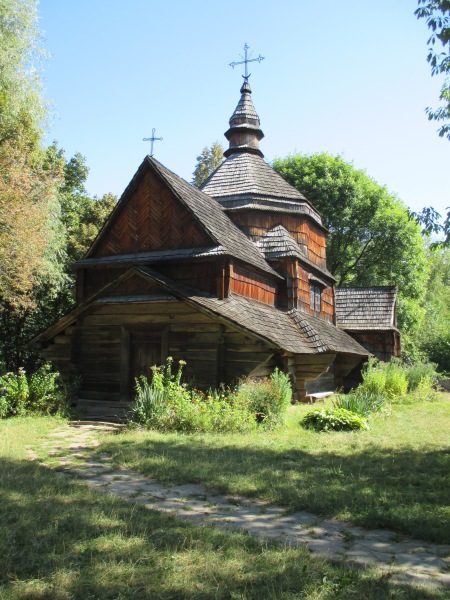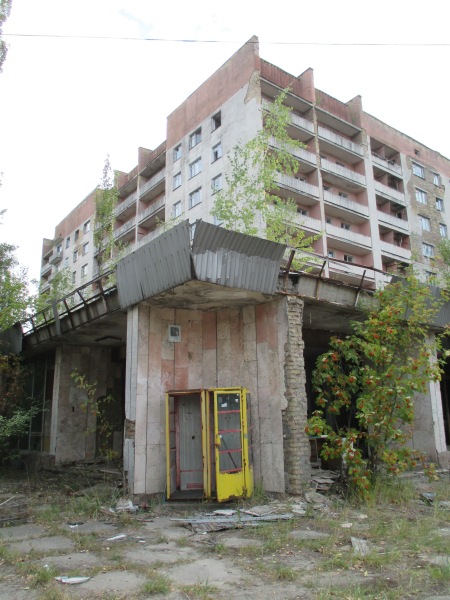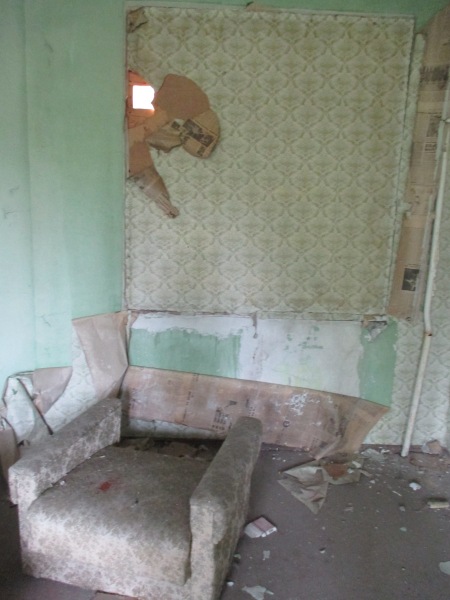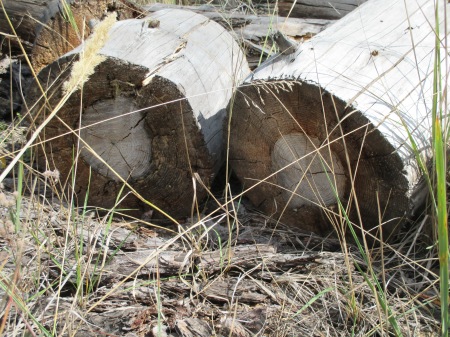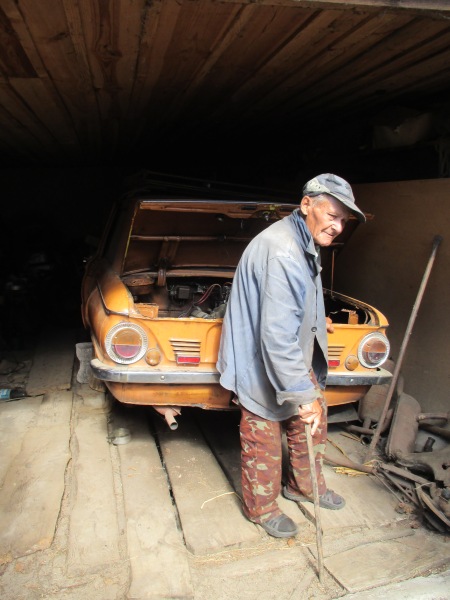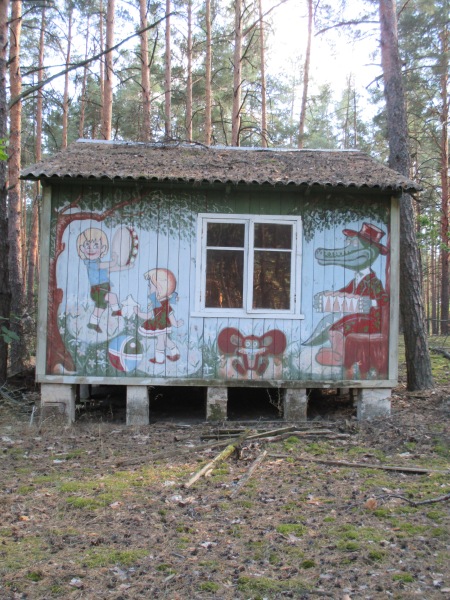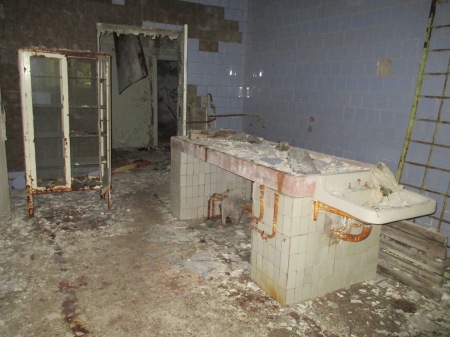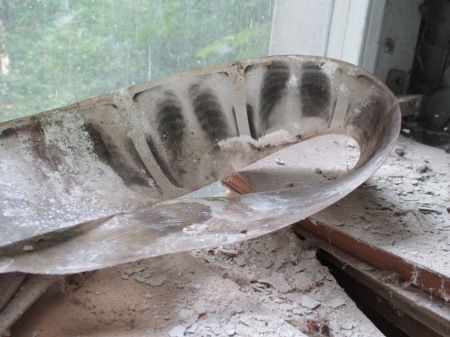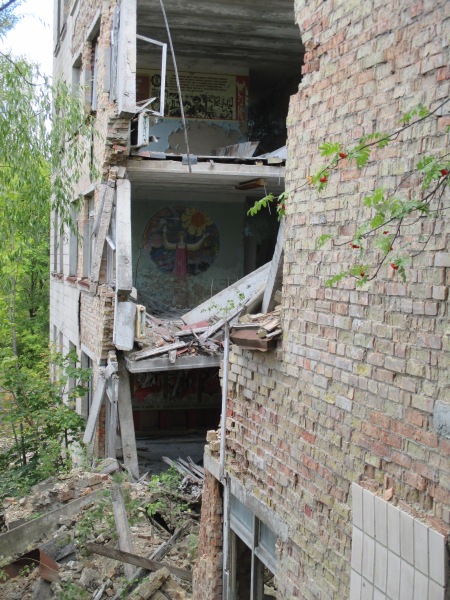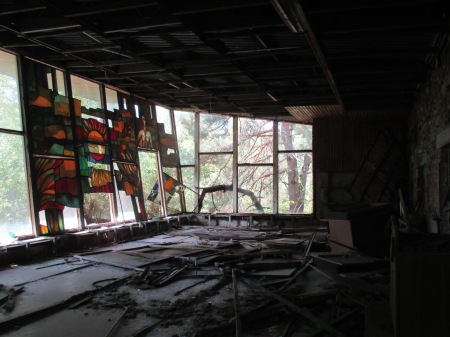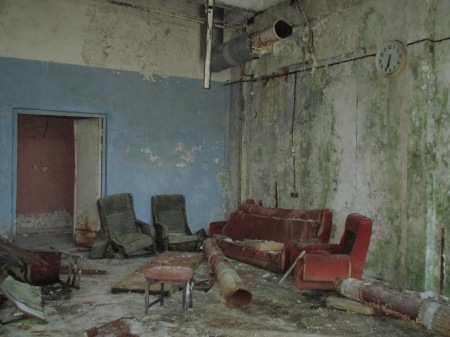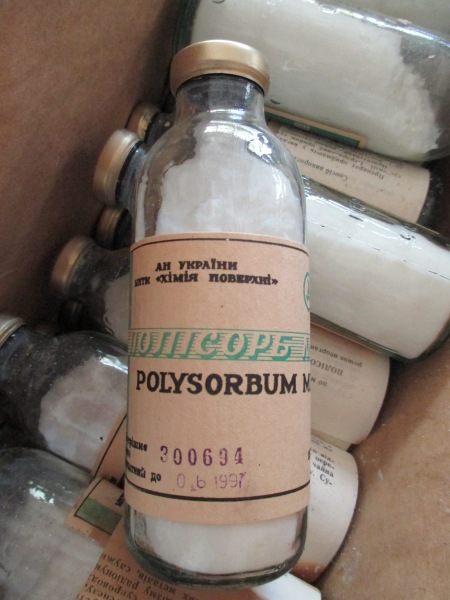After a brief stop at Pripyat’s sign which is a bit outside the place, we had another very small checkpoint to go past and then we were surrounded by tall buildings which have become rather obscured by trees. It is amazing how overgrown things have become. We spent pretty much all day in Pripyat and only saw a tiny portion of it. Until the disaster, Pripyat housed around 50,000 Chernobyl Plant workers and their families. It is definitely different from other abandoned places I’ve visited as there were many tall buildings (some as high as 16 storeys) and facilities (eg. swimming pools) you’d never find in regular ghost towns.
The first building we entered was one of the 16-storey apartment buildings. There was a small children’s library on the first floor. The city of Pripyat had a children’s library in each district. From the roof of the building, we had a nice view of the city as well as the power plant. About half the way to the roof, you have to go outside before entering the next flight of stairs. The apartments seemed on the small side to me but were apparently considered very large and nice by Soviet standards as each apartment had both a bathroom and a kitchen whereas it was quite common in other places for those to be shared among several families. I explored a few floors of the building. Of course, many of the apartments were largely empty as people have pretty much stolen everything of value over the years but I did find a few interesting things. I think my favourite finds were a piano and a photo of a man. I came to find a surprising number of pianos during this trip; this was probably because they were so heavy and difficult to move rather than because they were abnormally common there. I also really liked the doors to a lot of the apartments which were covered in padding to help mitigate noise.
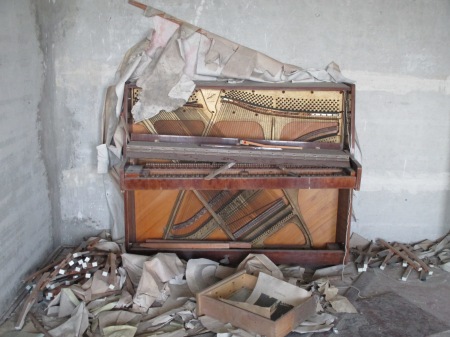
A piano in one of the upper floor apartments.
Next we headed to an amusement park. It was scheduled to open on May 1, 1986 but because of the disaster on April 26 it never opened. I hadn’t expected it to be small and right in the middle of the city but it is! As the bumper cars are somewhat high in radioactivity I didn’t set in one. It looks like several of the bumper cars are missing but, other than one sitting along a road, who knows where the rest ended up. I did sit on the ferris wheel though!

Sitting on the ferris wheel.
A very short walk away was the culture centre. It was quite large. It contained a boxing ring, a small swimming pool, a gym, a small and large theatre, dressing rooms, and a variety of unidentifiable rooms. There were lots of interesting signs and murals too.
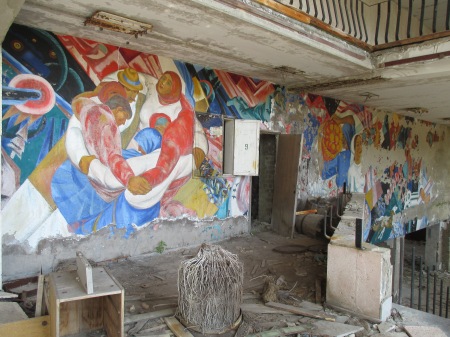
Inside the culture centre.
Another short walk away was the supermarket and a restaurant. The two-level supermarket (which sounds like what is called a hypermarket in the UAE) was only the second supermarket in the entire Soviet Union after one in Moscow. They sold exotic things like oranges! When the store was open groceries were sold downstairs while furniture was sold upstairs. Now what is left of the furniture is also on the ground level. It seems weird that people went to the work to move it but not actually take it away.

The supermarket.
We had lunch at the workers’ cafeteria at the power plant. The food was actually pretty good and it was a lot quicker to head there than to go all the way back to the hotel.
We then went to the see the big catfish near the power plant. I initially thought that this might not be terribly interesting but they were truly gigantic like sharks or river monsters or something! It was difficult to get pictures of them as they quickly disappeared after eating bread. While one might assume that they’re some enormous because of being radioactive mutants the true is simply that they have no natural predators.
We then headed over to look at the outside of the plant and of the new sarcophagus which should be completed by the end of this year. This was one of the few places were there were restrictions on what we could photograph. We could photograph reactor #4 where the disaster occurred and the new sarcophagus but not the (rather boring) looking building in between them.

Where the accident happened.
We then headed back into Pripyat and visited a kindergarten (daycare). It was a large one and had about 300 students. There were lots of classrooms and nap rooms. There were plenty of beds and toys around and quite a few posters too. To see the second floor you either had to walk on the roof between sections of head downstairs and then back up another set of stairs. I didn’t have time to see the whole building but I did see quite a bit of it. The second floor was definitely in worse condition than the first floor.
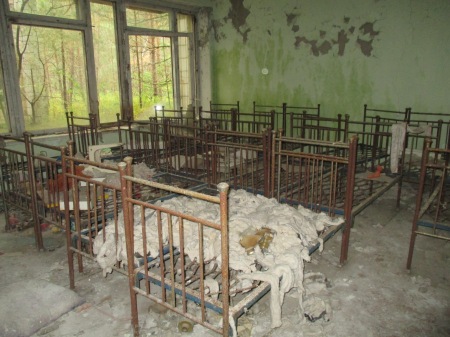
Inside the kindergarten.
Then we headed to a building housing a huge swimming pool as well as a gymnasium. I was shocked to discover that the pool was in use until 1996 (ten years after the disaster) and they only stopped using it because of financial reasons. I’d always assumed that after the disaster Pripyat was totally abandoned but that was not the case. While people stopped living in the city a few buildings were used into the 1990s and the laundry is actually still in use today.
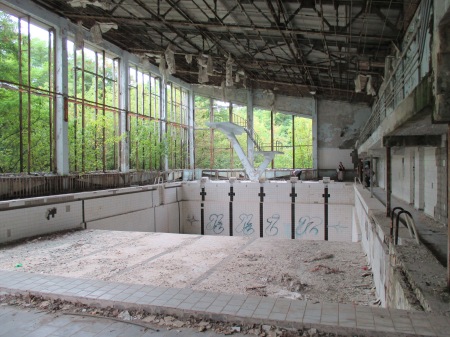
The swimming pool.
Another very short walk led to School#3. It was a fairly large school. It’s cafeteria is filled with gas masks. On the second floor, I found grass growing through some of the floors. Some of the classrooms were pretty intact while others were totally trashed. The physics lab, for instance, was in not too bad of shape. There were quite a few desks and lots of signs including propaganda. I found an area with lots of books on the floor and was told this is where the library was but I couldn’t tell which room had been the library and none of the rooms was all that large.
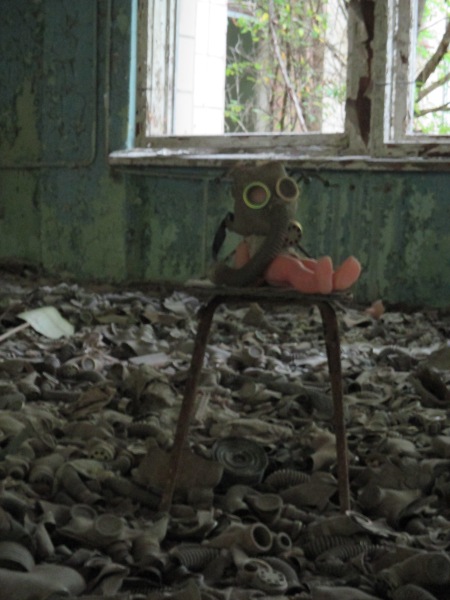
Some of the many gas masks in the cafeteria.
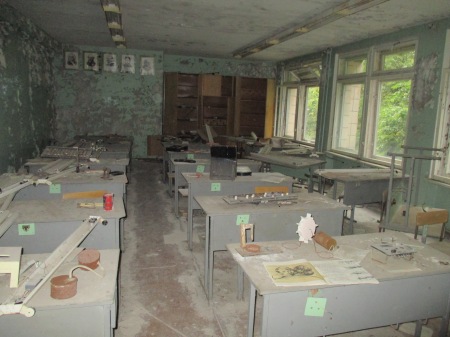
The physics lab.
We then headed to the post office. There was less to see here but there was a really cool space mural in there.
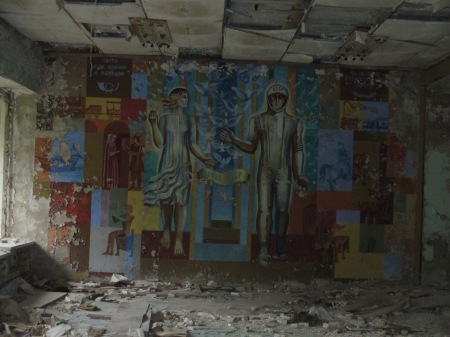
Space mural in the post office.
After leaving Pripyat we stopped at a small kindergarten in Kopachi. This one would have housed less than 50 children but at this one they lived here during the week and only went back to their families on weekends. This type of kindergarten was apparently common in the Soviet Union and our guide’s sister had attended one. The rest of the village was bulldozed after the disaster. This village is very close to the power plant. The kindergarten itself is safe enough but there are hotspots literally right outside the building.
I found Pripyat to be almost completely unrecognizable when compared to photos taken when the city was inhabited. I think one could spend weeks here and not see everything in the city. I really can’t even imagine how rushed the one-day tours of the zone must be!
